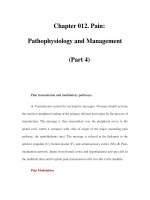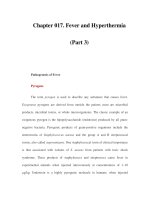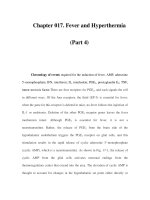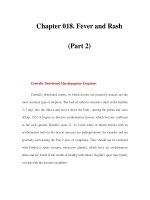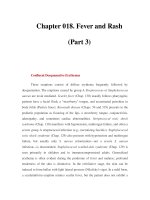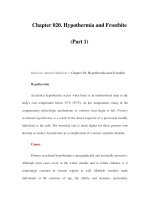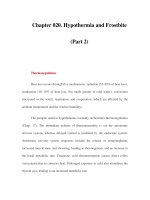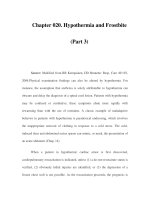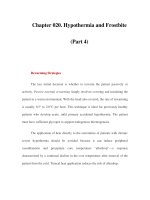Chapter 020. Hypothermia and Frostbite (Part 4) pot
Bạn đang xem bản rút gọn của tài liệu. Xem và tải ngay bản đầy đủ của tài liệu tại đây (16.56 KB, 6 trang )
Chapter 020. Hypothermia and Frostbite
(Part 4)
Rewarming Strategies
The key initial decision is whether to rewarm the patient passively or
actively. Passive external rewarming simply involves covering and insulating the
patient in a warm environment. With the head also covered, the rate of rewarming
is usually 0.5° to 2.0°C per hour. This technique is ideal for previously healthy
patients who develop acute, mild primary accidental hypothermia. The patient
must have sufficient glycogen to support endogenous thermogenesis.
The application of heat directly to the extremities of patients with chronic
severe hypothermia should be avoided because it can induce peripheral
vasodilatation and precipitate core temperature "afterdrop"—a response
characterized by a continual decline in the core temperature after removal of the
patient from the cold. Truncal heat application reduces the risk of afterdrop.
Active rewarming is necessary under the following circumstances: core
temperature < 32°C (poikilothermia), cardiovascular instability, age extremes,
CNS dysfunction, hormone insufficiency, or suspicion of secondary hypothermia.
Active external rewarming is best accomplished with forced-air heating blankets.
Other options include radiant heat sources and hot packs. Monitoring a patient
with hypothermia in a heated tub is extremely difficult. Electric blankets should be
avoided because vasoconstricted skin is easily burned.
There are numerous widely available active core rewarming options.
Airway rewarming with heated humidified oxygen (40°–45°C) is a convenient
option via mask or endotracheal tube. Although airway rewarming provides less
heat than some other forms of active core rewarming, it eliminates respiratory heat
loss and adds 1°–2°C to the overall rewarming rate. Crystalloids should be heated
to 40°–42°C, but the quantity of heat provided is significant only during massive
volume resuscitation. The most efficient method for heating and delivering fluid or
blood is with a countercurrent in-line heat exchanger. Heated irrigation of the
gastrointestinal tract or bladder transfers minimal heat because of the limited
available surface area. These methods should be reserved for patients in cardiac
arrest and then used in combination with all available active rewarming
techniques. Closed thoracic lavage is far more efficient in severely hypothermic
patients with cardiac arrest. The hemithoraces are irrigated through two large-bore
thoracostomy tubes that are inserted into the hemithoraces. Thoracostomy tubes
should not be placed in the left chest of a spontaneously perfusing patient for
purposes of rewarming. Peritoneal lavage with the dialysate at 40°–45°C
efficiently transfers heat when delivered through two catheters with outflow
suction. Like peritoneal dialysis, standard hemodialysis is especially useful for
patients with electrolyte abnormalities, rhabdomyolysis, or toxin ingestions.
Extracorporeal blood rewarming options (Table 20-3) should be considered
in severely hypothermic patients, especially those with primary accidental
hypothermia. Cardiopulmonary bypass should be considered in nonperfusing
patients without documented contraindications to resuscitation. Circulatory
support may be the only effective option in patients with completely frozen
extremities, or those with significant tissue destruction coupled with
rhabdomyolysis. There is no evidence that extremely rapid rewarming improves
survival in perfusing patients. The best strategy is usually a combination of
passive, truncal active, and active core rewarming techniques.
Table 20-3 Options for Extracorporeal Blood Rewarming
Extracorporeal
Rewarming (ECR)
Technique
Considerations
Venovenous
(VV)
Circuit—CV catheter to CV or peripheral
catheter
No oxygenator/circulatory support
Flow rates 150–400 mL/min
ROR 2°–3°C/h
Hemodialysis
(HD)
Circuit—single or dual vessel cannulation
Stabilizes electrolyte or toxicologic
abnormalities
Exchange cycle volumes 200–500 mL/min
ROR 2°–3°C/h
Continuous
arteriovenous rewarming
Circuit—percutaneous 8.5 Fr femoral catheters
(CAVR)
Requires BP 60 mmHg systolic
No perfusionist/pump/anticoagulation
Flow rates 225–375 mL/min
ROR 3°–4°C/h
Cardiopulmonary
bypass (CPB)
Circuit—full circulatory support with pump and
oxygenator
Perfusate-temperature gradient (5°–10°C)
Flow rates 2–7 L/min (ave. 3–4)
ROR up to 9.5°C/h
Note: BP, blood pressure; CV, central venous; ROR, rate of
rewarming.[newpage]
